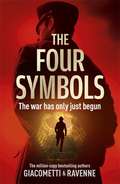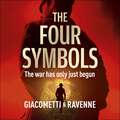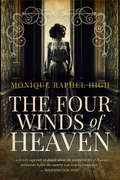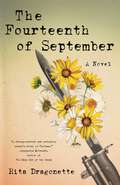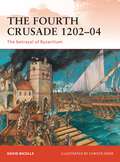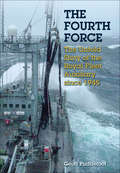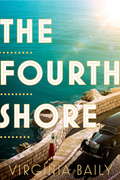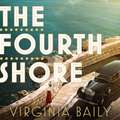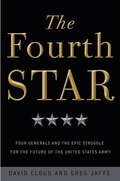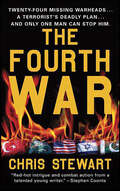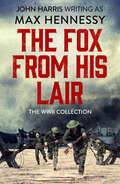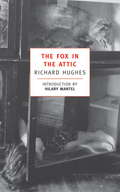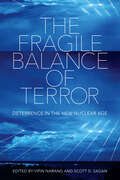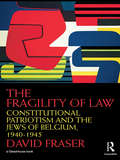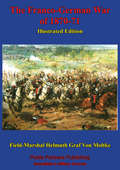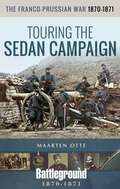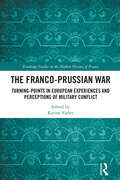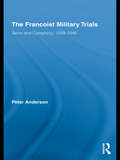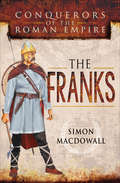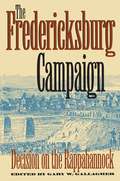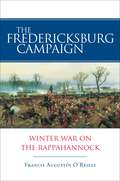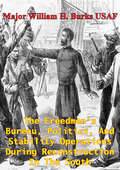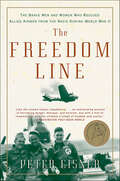- Table View
- List View
The Four Symbols: The Black Sun Series, Book 1
by Giacometti RavenneFrom multi-million copy bestselling authors Giacometti & Ravenne comes a Nazi spy thriller for fans of Dan Brown, Steve Berry and Wilbur Smith"I couldn't put it down ... the authors write like Dan Brown!" -Anthony, 5-Star NetGalley reviewer*** RATED 5 STARS BY REAL READERS *** *** GET BOOK 2, GOOD & EVIL, NOW: https://amz.run/3tyl ****** PREORDER BOOK 3, HELLBOUND, NEXT: https://amz.run/3tyk ***A secret Nazi organisation.Four swastikas with occult powers.A spy.What readers think:"I can't wait to read the next book in the series!" -Sens Critique"A spellbinding read from start to finish." -5-Star Amazon Review"There are twists aplenty" -5-Star Netgalley Review"A real page turner." -Art Six Mic"If you like books with lots of action and cliff hangers, this is for you." -5-Star Netgalley Review"The authors' best book so far." -5-Star Amazon Review"A book full of action and mystery." -Au Detour d'un LivreIn a Europe on the verge of collapse, the Nazi organisation Ahnenerbe is pillaging sacred landmarks across the world. Their aim is to collect treasures with occult powers, which will help them establish the Third Reich. The organisation's head, Himmler, has sent SS officers to search a forgotten sanctuary in the Himalayas, while he tries to track down a mysterious painting. Which ancient power do the Nazis believe they hold the key to?Meanwhile, in London, Churchill has discovered that the war against Germany will also be a spiritual one: their light must fight the occult if they are to win . . .
The Four Symbols: The Black Sun Series, Book 1 (The Black Sun Series #1)
by Giacometti RavenneFrom multi-million copy bestselling authors Giacometti & Ravenne comes a Nazi spy thriller for fans of Dan Brown, Steve Berry and Wilbur Smith"I couldn't put it down ... the authors write like Dan Brown!" -Anthony, 5-Star NetGalley reviewer*** RATED 5 STARS BY REAL READERS *** *** GET BOOK 2, GOOD & EVIL, NOW: https://amz.run/3tyl ****** PREORDER BOOK 3, HELLBOUND, NEXT: https://amz.run/3tyk ***A secret Nazi organisation.Four swastikas with occult powers.A spy.What readers think:"I can't wait to read the next book in the series!" -Sens Critique"A spellbinding read from start to finish." -5-Star Amazon Review"There are twists aplenty" -5-Star Netgalley Review"A real page turner." -Art Six Mic"If you like books with lots of action and cliff hangers, this is for you." -5-Star Netgalley Review"The authors' best book so far." -5-Star Amazon Review"A book full of action and mystery." -Au Detour d'un LivreIn a Europe on the verge of collapse, the Nazi organisation Ahnenerbe is pillaging sacred landmarks across the world. Their aim is to collect treasures with occult powers, which will help them establish the Third Reich. The organisation's head, Himmler, has sent SS officers to search a forgotten sanctuary in the Himalayas, while he tries to track down a mysterious painting. Which ancient power do the Nazis believe they hold the key to?Meanwhile, in London, Churchill has discovered that the war against Germany will also be a spiritual one: their light must fight the occult if they are to win . . .
The Four Symbols: The Black Sun Trilogy, Book 1 (The Black Sun Series #1)
by Giacometti RavenneFrom multi-million copy bestselling authors Giacometti & Ravenne comes a Nazi spy thriller for fans of Dan Brown, Steve Berry and Wilbur Smith."I couldn't put it down ... the authors write like Dan Brown!" -Anthony, 5-Star NetGalley reviewer*** RATED 5 STARS BY REAL READERS *** *** GET BOOK 2, GOOD & EVIL, NOW: https://amz.run/3tyl ****** PREORDER BOOK 3, HELLBOUND, NEXT: https://amz.run/3tyk ***A secret Nazi organisation.Four swastikas with occult powers.A spy.What readers think:"I can't wait to read the next book in the series!" -Sens Critique"A spellbinding read from start to finish." -5-Star Amazon Review"There are twists aplenty" -5-Star Netgalley Review"A real page turner." -Art Six Mic"If you like books with lots of action and cliff hangers, this is for you." -5-Star Netgalley Review"The authors' best book so far." -5-Star Amazon Review"A book full of action and mystery." -Au Detour d'un LivreIn a Europe on the verge of collapse, the Nazi organisation Ahnenerbe is pillaging sacred landmarks across the world. Their aim is to collect treasures with occult powers, which will help them establish the Third Reich. The organisation's head, Himmler, has sent SS officers to search a forgotten sanctuary in the Himalayas, whilst he tries to track down a mysterious painting. Which ancient power do the Nazis believe they hold the key to?Meanwhile, in London, Churchill has discovered that the war against Germany will also be a spiritual one: their light must fight the occult if they are to win . . .(P) 2020 Hodder & Stoughton Ltd
The Four Winds of Heaven
by Monique Raphel HighAs one prominent Jewish family, the Gunzburgs fight for their principles, the rest of Russia adheres to the malicious and unfaltering laws of the Tsar. Torn between what is expected of them and what their hearts truly want, the Gunzburgs begin to forge a new path--in search of their own identity and place in a world full of forbidden love, shattering betrayals, and war. Can they find where they truly belong and where their passion lies while the dynasty crumbles around them? Inspired by the diaries of Monique Raphel High's grandmother, this epic saga will take readers on a journey through Russian history through one woman's eyes.
The Fourteenth of September: A Novel
by Rita DragonetteA Readers' Favorite Book Award Finalist and Best Book Awards Finalist * Featured in Ms. Magazine, Brit + Co, Hypertext Magazine, BookTrib, Publishers Weekly, Writer's Digest and more! An enthralling historical novel about brave women set during the peak of the Vietnam War and told through the rare perspective of a young woman, who traces her path to self-discovery and a “Coming of Conscience.”If you loved Kristin Hannah's latest novel The Women, this one's for you.On September 14, 1969, Private First Class Judy Talton celebrates her nineteenth birthday by secretly joining the campus anti-Vietnam War movement. In doing so, she jeopardizes both the army scholarship that will secure her future and her relationship with her military family. But Judy’s doubts have escalated with the travesties of the war. Who is she if she stays in the army? What is she if she leaves?When the first date pulled in the Draft Lottery turns up as her birthday, she realizes that if she were a man, she’d have been Number One―off to Vietnam with an under-fire life expectancy of six seconds. The stakes become clear, propelling her toward a life-altering choice as fateful as that of any draftee.Judy’s story speaks to the poignant clash of young adulthood, early feminism, and war, offering an ageless inquiry into the domestic politics of protest when the world stops making sense.
The Fourth Crusade 1202-04
by David Nicolle Christa HookThe Fourth Crusade was the first and most famous of the 'diverted' crusades, that is, ones diverted from their originally intended target. It was also the first to be directed against a fellow Christian, though Orthodox, state. Initially preached (from 1198 onwards) as a campaign against Ayyubid Egypt, which was correctly seen as the most potent threat to the Latin or 'Crusader' Kingdom of Jerusalem, its first Christian target was the city of Zadar in what is now Croatia. The greater part of the crusading army then attacked the Byzantine capital of Constantinople, again as part of their obligations to Venice. The result was a siege and the first capture of that great city in 1203. This title will highlight all the intrigue, deception, and betrayal of this tumultuous Crusade.From the Trade Paperback edition.
The Fourth Force: The Untold Story of the Royal Fleet Auxiliary Since 1945
by Geoff PuddefootSet up in August 1905, the Royal Fleet Auxiliary was originally a logistic support organization, part of the Navy proper but run on civilian lines, comprising a miscellaneous and very unglamorous collection of colliers, store ships and harbor craft. Just over a century later it has evolved beyond recognition: its ships compare in size, cost and sophistication with all but the largest warships, and the RFA itself has developed into an essential arm of all three Services. It is truly the Fourth Force as it is known to its own personnel and without it, the current worldwide deployment of British service men and women would be simply impossible.This book charts the veritable revolution that has overtaken the RFA since the end of the Second World War. New technology and techniques reflect the rapid growth in the importance of logistics in modern warfare, while the broadening role of the RFA is to be seen in the history of its operations, many of them little known to the public. Woven together from a combination of technical ship data, official correspondence and personal recollections, it is predominantly about the men and women of the RFA and their stories an insight into the underreported history of a service whose initials unofficially translate as Ready For Anything.
The Fourth Shore
by Virginia Baily'Effortlessly enjoyable . . . an emotionally rewarding novel so succulent with detail that you can almost feel the Tripoli sand storms whipping across your face' Daily Mail The Fourth Shore: the sliver of fertile land along the Tripoli coast, the 'lost' territory Mussolini promised to reclaim for Italy. Which is how, in 1929, seventeen-year-old Liliana Cattaneo arrives there from Rome on a ship filled with eager colonists to join her brother and his new wife.Liliana is sure she was on the brink of a great adventure, but what awaits her is not the Mediterranean idyll of cocktail parties, smart dances, dashing officers and romantic intrigues she had imagined. Instead she finds a world of persecution, violence, repression, corruption and deceptions both great and small. A child of fascist Italy, blown about by the winds of fascism and Catholicism, Liliana becomes enmeshed in a dark liaison which has terrible consequences both for her and those she loves most. The Fourth Shore is the engrossing and intensely poignant story of Liliana's journey from Rome to Tripoli to a north London suburb where, as plain Lily Jones, she begins to uncover a secret she has buried so deeply that even she is far from certain what it is.Praise for Early One Morning by Virginia Baily:'As gripping as any thriller...really, really good' Daily Mail'A big, generous and absorbing piece of storytelling' Samantha Harvey, Guardian'A real treat' Philip Hensher, Observer'Wonderful' Tessa Hadley
The Fourth Shore
by Virginia BailyThe Fourth Shore: the sliver of fertile land along the Tripoli coast, the 'lost' territory Mussolini promised to reclaim for Italy. Which is how, in 1929, seventeen-year-old Liliana Cattaneo arrives there from Rome on a ship filled with eager colonists to join her brother and his new wife.Liliana is sure she was on the brink of a great adventure, but what awaits her is not the Mediterranean idyll of cocktail parties, smart dances, dashing officers and romantic intrigues she had imagined. Instead she finds a world of persecution, violence, repression, corruption and deceptions both great and small. A child of fascist Italy, blown about by the winds of fascism and Catholicism, Liliana becomes enmeshed in a dark liaison which has terrible consequences both for her and those she loves most. The Fourth Shore is the engrossing and intensely poignant story of Liliana's journey from Rome to Tripoli to a north London suburb where, as plain Lily Jones, she begins to uncover a secret she has buried so deeply that even she is far from certain what it is.Praise for Early One Morning by Virginia Baily:'As gripping as any thriller...really, really good' Daily Mail'A big, generous and absorbing piece of storytelling' Samantha Harvey, Guardian'A real treat' Philip Hensher, Observer'Wonderful' Tessa Hadley
The Fourth Star: Four Generals and the Epic Struggle for the Future of the United States Army
by David Cloud Greg JaffeThey were four exceptional soldiers, a new generation asked to save an army that had been hollowed out after Vietnam. They survived the military's brutal winnowing to reach its top echelon. They became the Army's most influential generals in the crucible of Iraq. Collectively, their lives tell the story of the Army over the last four decades and illuminate the path it must travel to protect the nation over the next century. Theirs is a story of successes and failures, of ambitions achieved and thwarted, of the responsibilities and perils of command. The careers of this elite quartet show how the most powerful military force in the world entered a major war unprepared, and how the Army, drawing on a reservoir of talent that few thought it possessed, saved itself from crushing defeat against a ruthless, low-tech foe. In The Fourth Star, you'll follow:*Gen. John Abizaid, one of the Army's most brilliant minds. Fluent in Arabic, he forged an unconventional path in the military to make himself an expert on the Middle East, but this unique background made him skeptical of the war he found himself leading. *Gen. George Casey Jr., the son of the highest-ranking general to be killed in the Vietnam War. Casey had grown up in the Army and won praise for his common touch and skill as a soldier. He was determined not to repeat the mistakes of Vietnam but would take much of the blame as Iraq collapsed around him. *Gen. Peter Chiarelli, an emotional, take-charge leader who, more than any other senior officer, felt the sting of the Army's failures in Iraq. He drove his soldiers, the chain of command, and the U.S. government to rethink the occupation plans-yet rarely achieved the results he sought.*Gen. David Petraeus, a driven soldier-scholar. Determined to reach the Army's summit almost since the day he entered West Point, he sometimes alienated peers with his ambition and competitiveness. When he finally got his chance in Iraq, he-more than anyone-changed the Army's conception of what was possible. Masterfully written and richly reported, The Fourth Star ranges far beyond today's battlefields, evoking the Army's tumultuous history since Vietnam through these four captivating lives and ultimately revealing a fascinating irony: In an institution that prizes obedience, the most effective warriors are often those who dare to question the prevailing orthodoxy and in doing so redefine the American way of war.From the Hardcover edition.
The Fourth War
by Chris StewartAlong the Afghanistan border, a CIA agent meets secretly with a distraught Arab girl. She passes him a coded message before killing herself. But before the message can be deciphered, the world spins toward war: Within hours, the president of Pakistan is assassinated, and the country's nuclear warheads go missing. Al Qaeda streams into northern Pakistan. Israel puts her combat forces on hair-trigger alert. CIA paramilitary agent Peter Zembeic is given the impossible task of finding and destroying the missing warheads. Working with his best friend, a B-2 pilot, they develop a desperate plan to save the world from the threat of nuclear terror.
The Fox From His Lair: The WWII Collection
by Max HennessyTwo Allied officers hunt down a German agent who&’s stolen top-secret plans that could change the course of World War II in this spy thriller. Throughout the summer of 1944, southern England was transformed into one huge armed camp as the Allied forces made their final preparations for D-Day. It was at this crucial moment in history that the Fox emerged from his lair. The Fox had many names and many disguises, but behind them all lay the resource and ingenuity of a dedicated German agent. His very existence was not suspected until a totally unexpected E-Boat attack on a landing resulting in hundreds of casualties, and the loss of a set of top-secret plans detailing the invasion. Desperate to stop them falling into enemy hands, two officers are tasked with recovering the plans and taking out the Fox. Failure would mean the total defeat of the Allied forces. Failure is not an option . . . Perfect for fans of Frederick Forsyth, John le Carré and Alistair MacLean.
The Fox in the Attic
by Hilary Mantel Richard HughesA tale of enormous suspense and growing horror, The Fox in the Attic is the widely acclaimed first part of Richard Hughes's monumental historical fiction, "The Human Predicament." Set in the early 1920s, the book centers on Augustine, a young man from an aristocratic Welsh family who has come of age in the aftermath of World War I. Unjustly suspected of having had a hand in the murder of a young girl, Augustine takes refuge in the remote castle of Bavarian relatives. There his hopeless love for his devout cousin Mitzi blinds him to the hate that will lead to the rise of German fascism. The book reaches a climax with a brilliant description of the Munich putsch and a disturbingly intimate portrait of Adolph Hitler. The Fox in the Attic, like its no less remarkable sequel The Wooden Shepherdess, offers a richly detailed, Tolstoyan overview of the modern world in upheaval. At once a novel of ideas and an exploration of the dark spaces of the heart, it is a book in which the past returns in all its original uncertainty and strangeness.
The Fragile Balance of Terror: Deterrence in the New Nuclear Age (Cornell Studies in Security Affairs)
by Vipin Narang and Scott D. SaganIn The Fragile Balance of Terror, the foremost experts on nuclear policy and strategy offer insight into an era rife with more nuclear powers. Some of these new powers suffer domestic instability, others are led by pathological personalist dictators, and many are situated in highly unstable regions of the world—a volatile mix of variables.The increasing fragility of deterrence in the twenty-first century is created by a confluence of forces: military technologies that create vulnerable arsenals, a novel information ecosystem that rapidly transmits both information and misinformation, nuclear rivalries that include three or more nuclear powers, and dictatorial decision making that encourages rash choices. The nuclear threats posed by India, Pakistan, Iran, and North Korea are thus fraught with danger.The Fragile Balance of Terror, edited by Vipin Narang and Scott D. Sagan, brings together a diverse collection of rigorous and creative scholars who analyze how the nuclear landscape is changing for the worse. Scholars, pundits, and policymakers who think that the spread of nuclear weapons can create stable forms of nuclear deterrence in the future will be forced to think again.Contributors: Giles David Arceneaux, Mark S. Bell, Christopher Clary, Peter D. Feaver, Jeffrey Lewis, Rose McDermott, Nicholas L. Miller, Vipin Narang, Ankit Panda, Scott D. Sagan, Caitlin Talmadge, Heather Williams, Amy Zegart
The Fragility of Law: Constitutional Patriotism and the Jews of Belgium, 1940–1945
by David FraserThe Fragility of Law examines the ways in which, during the Second World War, the Belgian government and judicial structure became implicated in the identification, exclusion and killing of its Jewish residents, and in the theft - through Aryanization - of Jewish property. David Fraser demonstrates how a series of political and legal compromises meant that the infrastructure for antisemitic persecutions and ultimately the deaths of thousands of Belgian Jews was Belgian. Based on extensive archival research in Belgium, France, the United States and Israel, The Fragility of Law offers the first detailed exploration in English of this intriguing and virtually unexplored episode of Holocaust history. Belgian legal officials did not hesitate to invoke the provisions of international law found in the Hague Convention and those guarantees of individual freedom found in the national Constitution to oppose the demands of the German Occupying Authority. However, they remained largely silent when anti-Jewish persecution was at stake. Indeed, despite the 2007 official report of expert historians on Belgian state collaboration in the persecution of the country’s Jewish population, the mythology of "passive collaboration" which has dominated Belgian historiography and accounts of the Holocaust in that country, must be radically rethought.
The Franco-German War Of 1870-71 [Illustrated Edition]
by Field-Marshal Helmuth Graf Von MoltkeIllustrated with over 30 maps and diagrams of the War.There are few military strategists that can be mentioned in the same breath as Field-Marshal Helmuth Graf Von Moltke, a towering military figure who helped define the Federal German state with his military brilliance. Although born into a Danish family and trained for the Danish Army, he transferred to the Prussian army and by 1822 he was enrolled at the famous Prussian Kriegsakadamie, studying under the revered Clausewitz. He fully digested the organic theories of warfare expounded by Clausewitz, and enhanced his already brilliant prospects by studying languages and devouring literature and history with equal gusto. He was one of the first to realize the military potential of the new railway networks that were being built across Europe around this time, a factor that would shape the Prussian/German war planning for years to come.Having gained the pinnacle of his profession as the Chief of the General Staff in 1857; the next fourteen years would place a heavy burden on him at the head of the German Land Forces that would be the cutting edge of Teutonic expansion. He tested his theories of war first in the war of 1866 against the Austrians pulling off the astonishing victory of Königgratz by a combination of brilliant planning, superior fighting ability, swift marching and trust in his subordinates. His greatest successes would be against the much vaunted French army in 1870-71. he realized that although numbers would be against them the German military machine was much more effective at mobilization, manoeuvre and above all drive and determination. The story of his successes during the war are recounted in this volume with reticence, modesty and honesty; he is very careful not point out too many of the errors of the German Generals but spares none of the French commanders.An excellent war memoir from a renowned general widely regarded as one of the foremost military strategists of the 19th century.
The Franco-Prussian War
by Geoffrey WawroThe Franco-Prussian War of 1870–1871 violently changed the course of European History. Alarmed by Bismarck's territorial ambitions and the Prussian army's crushing defeats of Denmark in 1864 and Austria in 1866, French Emperor Napoleon III vowed to bring Prussia to heel. Digging into many European and American archives for the first time, Geoffrey Wawro's The Franco-Prussian War describes the war that followed in thrilling detail. While the armies mobilized in July 1870, the conflict appeared 'too close to call'. Prussia and its German allies overwhelmingly outnumbered the French. But Marshal Achille Bazaine's grognards ('old grumblers') were the stuff of legend, the most resourceful, battle-hardened, sharp-shooting troops in Europe. From the political intrigues that began and ended the war to the bloody battles at Gravelotte and Sedan and the last murderous fights on the Loire and in Paris, this is a stunning, authoritative history of the Franco-Prussian War.
The Franco-Prussian War, 1870–1871: Touring the Sedan Campaign (Battleground 1870–1871)
by Maarten Otte&“Masterfully written . . . This series provides the enthusiast and historian with volumes in which history is combined with tourism on the battlefields.&” —On the Old Barbed Wire In 1870 France embarked on a war with Prussia and her allied German states that was to be a complete disaster. For Napoleon III, after his ignominious surrender with thousands of his troops from the Army of the Rhine and the Army of Châlons, it meant his abdication and exile. For France it resulted in the humiliation of her army, a bitter civil war in Paris, the loss of two Provinces (Alsace and Lorraine) and a heavy indemnity. Maarten Otte provides background chapters to place the lead up to the war and the issues that were involved; he describes the makeup of the opposing armies and some of their principal commanders. The Sedan Campaign was fought over a relatively small area and the locations of some of the key battles have changed little, though some of those near the built-up areas, such as Sedan itself, require some imagination. After the war several German regiments erected monuments and a surprising number remain today, often hidden away in isolated fields and copses. Several communal cemeteries have a number of German graves. Perhaps one of the most macabre of these is the ossuary in Bazeilles, where the visitor is able to see skeletons that still have shreds of uniform and footwear on them. Sedan was also a focus of the most recent and bloody western European wars, and a notable feature of this battlefield is to see memorials to the conflicts of the twentieth century—the Great War and the Second World War.
The Franco-Prussian War: Turning-Points in European Experiences and Perceptions of Military Conflict (Routledge Studies in the Modern History of France)
by Karine VarleyThe Franco-Prussian War of 1870–71 has traditionally been seen as a limited conflict between French and German forces. This edited volume challenges this view and shows that it was a war of ideas, values, and perceptions, which transformed the political, diplomatic, and military culture across Europe.Based on interdisciplinary research, the book suggests that the war raised new questions about power, the nation, violence, and notions of civilization, which brought about a decisive shift in how warfare was experienced and perceived. While the Franco-Prussian War may have begun as a traditional dynastic struggle, it became a modern war and an important precursor to the First World War in its use of new weaponry and industrialized warfare. At the same time, the development of humanitarian movements and international law on the conduct of war meant that the fighting was subjected to unprecedented scrutiny, while new technologies accelerated the pace at which narratives about the war were constructed and consumed.This volume will appeal to scholars in the fields of war studies, international relations and diplomacy, and intellectual and cultural history. It will also be a useful addition to undergraduate and postgraduate courses on nineteenth-century European history and cultural studies.
The Francoist Military Trials: Terror and Complicity,1939-1945 (Routledge/Canada Blanch Studies on Contemporary Spain #Vol. 17)
by Peter AndersonIn Spain between 1936-1945, the Franco regime carried out one Europe’s more brutal but less remembered programs of mass repression. Many were murdered by the regime’s death squads, and in some areas Francoists also subjected up to 15% of the population to summary military trials. Here many suffered the death sentence or jail terms up to thirty years. Although historians have recognised the staggering scale of the trials, they have tended to overlook the mass participation that underpinned them. In contrast to the discussion in other European countries, little attention has been paid to the wide scale collusion in the killings and incarcerations in Spain. Exploring mass complicity in the trials of hundreds of thousands of defeated Republicans following the end of the Spanish Civil War, The Francoist Military Trials probes local Francoists’ accusations whereby victims were selected for prosecution in military courts. It also shows how insubstantial and hostile testimony formed the bedrock of ‘investigations’, secured convictions, and shaped the harsh sentencing practices of Franco’s military judges. Using civil court records, it also documents how grassroots Francoists continued harassing Republicans for many years after they emerged from prison. Challenging the popularly prevalent view that the Franco regime imposed a police state upon a passive Spanish society, the evidence Anderson uncovers here illustrates that local state officials and members of the regime’s support base together forged a powerful repressive system that allowed them to wage war on elements of their own society to a greater extent than perhaps even the Nazis managed against their own population.
The Franks: The Franks (Conquerors of the Roman Empire)
by Simon MacDowallHow a relatively small group of Germans came to be overlords of all of the former Roman province of Gaul—giving their name to France in the process. Simon MacDowall studies the Frankish way of warfare and assesses its effectiveness, from their earliest incursions into the Empire, down to the Battle of Casilinum (554), their last battle against Romans, The size and composition of their armies, their weapons (including the characteristic Francisca axe), equipment, and tactics are discussed. In this tumultuous period, the Franks had a complex relationship with the Romans, being by turns invaders, recruits to the legions, and independent allies. Accordingly, this book also covers the Franks’ role in defending the Rhine frontier against subsequent invasions by the Vandals, Alans, Suebi, and the Huns. Their success in defending their new homeland against all comers allowed them, under the leadership of the Merovingian dynasty of Clovis, to establish the Frankish kingdom as one of the most enduring of the “barbarian” successors to the power of Rome.
The Fredericksburg Campaign
by Gary W. GallagherIt is well this is so terrible! We should grow too fond of it," said General Robert E. Lee as he watched his troops repulse the Union attack at Fredericksburg on 13 December 1863. This collection of seven original essays by leading Civil War historians reinterprets the bloody Fredericksburg campaign and places it within a broader social and political context. By analyzing the battle's antecedents as well as its aftermath, the contributors challenge some long-held assumptions about the engagement and clarify our picture of the war as a whole. The book begins with revisionist assessments of the leadership of Ambrose Burnside and Robert E. Lee and a portrait of the conduct and attitudes of one group of northern troops who participated in the failed assaults at Marye's Heights. Subsequent essays examine how both armies reacted to the battle and how the northern and southern homefronts responded to news of the carnage at Frederickburg. A final chapter explores the impact of the battle on the residents of the Fredericksburg area and assesses changing Union attitudes about the treatment of Confederate civilians. The contributors are William Marvel, Alan T. Nolan, Carol Reardon, Gary W. Gallagher, A. Wilson Greene, George C. Rable, and William A. Blair.This collection of seven original essays by leading Civil War historians reinterprets the bloody Fredericksburg campaign and places it within a broader social and political context. By analyzing the battle's antecedents as well as its aftermath, the contributors challenge long-held assumptions about the engagement and clarify our picture of the war as a whole. The contributors are William Marvel, Alan T. Nolan, Carol Reardon, Gary W. Gallagher, A. Wilson Greene, George C. Rable, and William A. Blair.-->
The Fredericksburg Campaign: Winter War on the Rappahannock
by Francis Augustín O'ReillyThe battle at Fredericksburg, Virginia, in December 1862 involved hundreds of thousands of men; produced staggering, unequal casualties (13,000 Federal soldiers compared to 4,500 Confederates); ruined the career of Ambrose E. Burnside; embarrassed Abraham Lincoln; and distinguished Robert E. Lee as one of the greatest military strategists of his era. Francis Augustín O'Reilly draws upon his intimate knowledge of the battlegrounds to discuss the unprecedented nature of Fredericksburg's warfare. Lauded for its vivid description, trenchant analysis, and meticulous research, his award-winning book makes for compulsive reading.
The Freedmen’s Bureau, Politics, And Stability Operations During Reconstruction In The South
by Major William H. Burks USAFThe United States' Civil War ended in 1865. However, the post-conflict period immediately following, known as Reconstruction, lasted another twelve years. This era provides a great case study to examine the impacts of politics on military stability operations. This paper studies the Freedmen's Bureau during its existence from 1865 to 1872. Envisioned as the lead organization for integrating former slaves into American society, the Bureau's efforts in the post-Civil War South were undermined by a hostile political situation at the national and state level and a diminishing lack of popular support throughout the entire nation to embrace radical social changes. The Bureau's operational timeframe splits into three distinct periods: conflict with President Andrew Johnson from 1865 to early 1867, revamped efforts during Congressional Reconstruction from early 1867 to the end of 1868, and a reduced operational focus (primarily education) from 1869 to 1872. The Bureau faced manning challenges and fought racism as it worked to help former slaves become self-sufficient, educated, and true citizens of the nation in which they resided. Unfortunately, hostile political conditions meant much of the civil rights work accomplished by the Bureau was subdued after its demise until the Civil Rights Movement in the 1960s.
The Freedom Line: The Brave Men and Women Who Rescued Allied Airmen from the Nazis During World War II
by Peter EisnerCompared to Casablanca by the Washington Post, The Freedom Line is a page-turning story of a group of resistance workers who secreted downed Allied fighter pilots through France and into safety in Spain during World War II—perfect for fans of Apple TV's Masters of the Air.As war raged against Hitler's Germany, an increasing number of Allied fliers were shot down on missions against Nazi targets in occupied Europe. Many fliers parachuted safely behind enemy lines only to find themselves stranded and hunted down by the Gestapo. The Freedom Line traces the thrilling and true story of Robert Grimes, a 20–year–old American B–17 pilot whose plane was shot down over Belgium on Oct. 20, 1943. Wounded, disoriented, and scared, he was rescued by operatives of the Comet Line, a group of tenacious young women and men from Belgium, France, and Spain who joined forces to rescue the Allied aircrews and take them to safety. And on Christmas Eve 1943, he and a group of fellow Americans faced unexpected sudden danger and tragedy on the border between France and Spain.The road to safety was a treacherous journey by train, by bicycle, and on foot that stretched hundreds of miles across occupied France to the Pyrenees Mountains at the Spanish border. Armed with guile and spirit, the selfless civilian fighters of the Comet Line had risked their lives to create this underground railroad, and by this time in the war, they had saved hundreds of Americans, British, Australians, and other Allied airmen.Based on interviews with the survivors and in–depth archival research, The Freedom Line is the story of a group of friends who chose to act on their own out of a deep respect for liberty and human dignity. Theirs was a courage that presumed to take on a fearfully powerful foe with few defences.
